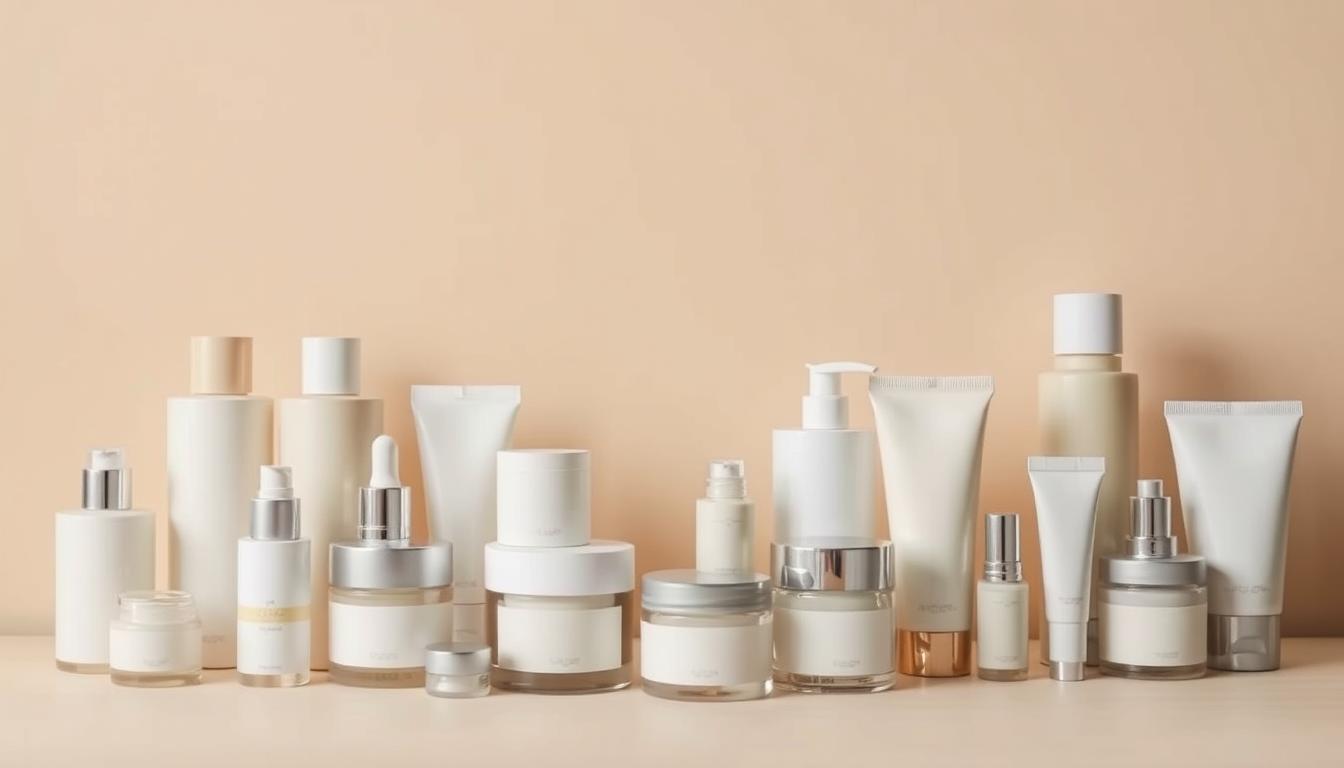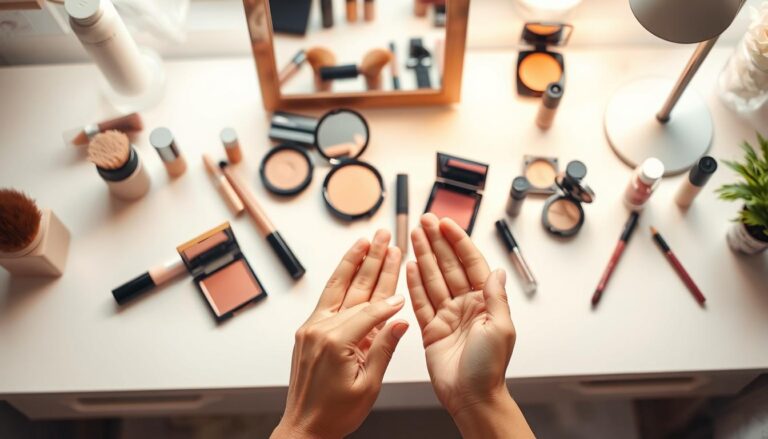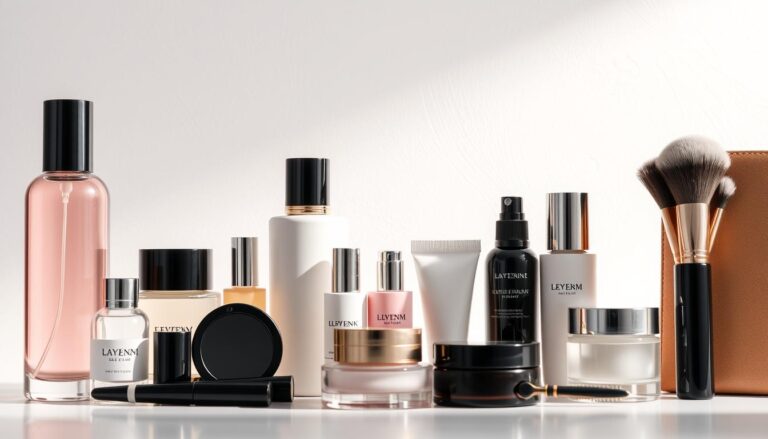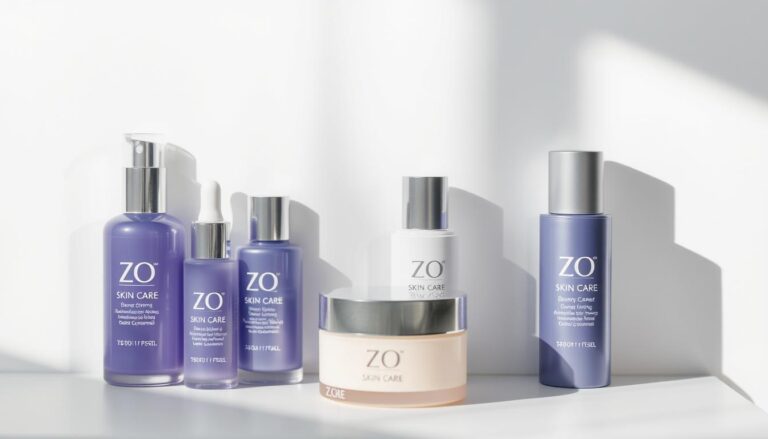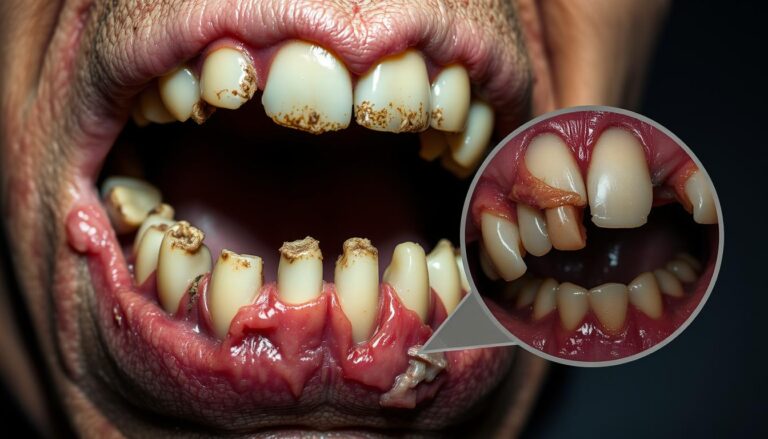Best Skincare Brands: How to Choose the Right One
Table of Contents
My journey into skincare was like navigating a complex maze. Every shelf seemed to scream with miraculous claims. I was overwhelmed and confused about which products would truly work for my skin.
Choosing the best skincare brands isn’t just about fancy packaging or trending marketing. It’s about understanding your unique skin needs. You need to decode ingredient lists and make informed choices that nurture your skin’s health.
Dermatologist Michele Green, MD, emphasizes that skin type is the most critical factor. With countless brands competing for your attention, knowing how to navigate this landscape can transform your skincare routine from guesswork to precision.
Choosing the right skincare isn’t a one-size-fits-all approach. It requires understanding your skin’s specific requirements. You need to research ingredients and select best skincare brands that align with your individual needs.
Key Takeaways
- Understand your unique skin type before selecting products
- Read ingredient labels carefully and prioritize active components
- Consult dermatologist-recommended skincare resources
- Consider patch testing new products
- Recognize that expensive doesn’t always mean better
- Prioritize skin health over trending products
- Prioritize skin health over trending products
Understanding Skincare Product Labels and Ingredients
Reading skincare labels can seem like solving a puzzle. With so many natural and vegan options, it’s key to know what you’re using on your skin.
When you grab a skincare product, the list of ingredients might confuse you. The International Nomenclature of Cosmetic Ingredients (INCI) helps make sense of it all. It’s a system used by both experts and everyday people.
Decoding the INCI System
The INCI system uses scientific names for ingredients. This can make labels look hard to understand. For example, tocopherol is just vitamin E. Here’s what you should know about ingredient lists:
- Ingredients are listed in descending order of concentration
- The first ingredient typically makes up 70-95% of the product
- Ingredients under 1% can be listed in any order
Reading Labels Like a Pro
To read labels well, look at the first five to six ingredients. These make up 80-90% of the product.
Focus on active ingredients that address your skin issues. For example, niacinamide at 2% can help your skin’s barrier. Vitamin C can range from a tiny amount to 20%.
The Importance of Active Ingredients
Not all ingredients are the same. Some, like astaxanthin, offer big benefits even at very low concentrations. It can protect against free radicals up to 10 times better than beta carotene with just 0.035%.
Understanding ingredient lists empowers you to make informed skincare choices.
Pro tip: Use apps like EWG’s Skin Deep Database to help understand complex ingredient lists. This way, you can make smart choices when buying skincare products.
The Role of Skin Type in Product Selection
Knowing your skin type is key to picking the right skincare. Different skin types need different products. Understanding your skin helps you find what’s best for you.
There are five main skin types, each with its own traits:
- Normal skin: Balanced and comfortable
- Oily skin: Excess sebum production
- Dry skin: Tight and potentially flaky
- Combination skin: Mixed characteristics
- Sensitive skin: Prone to irritation
For sensitive skin, you need to be careful. Look for gentle, hypoallergenic products that won’t irritate your skin.
To figure out your skin type, try these steps:
- Watch how your skin acts 30 minutes after you wash it
- Use blotting sheets to see how much oil your skin absorbs
- Get a professional opinion from a dermatologist
Choosing the right skincare products is about understanding your skin’s unique needs and responding accordingly.
Choosing the right products for your skin type can prevent problems like irritation and breakouts. For sensitive skin, always do patch tests and introduce new products slowly to avoid bad reactions.
Essential Ingredients for Different Skin Concerns
Skincare can be confusing. Your skin is special, and the right ingredients can change your routine. Let’s look at solutions for different skin types and issues.
Ingredients for Oily and Acne-Prone Skin
For oily and acne-prone skin, some ingredients are key:
- Salicylic acid: Clears pores
- Benzoyl peroxide: Kills bacteria that cause acne
- Niacinamide: Helps control oil
Benzoyl peroxide works well against pustules and cystic acne. It’s found in products with 2.5% to 10% concentration.
Ingredients for Dry and Sensitive Skin
Dry skin needs gentle, moisturizing ingredients. They help restore moisture and protect the skin:
- Hyaluronic acid: Keeps skin hydrated
- Ceramides: Improve skin’s moisture and elasticity
- Glycerin: A natural moisturizer for all skin types
Anti-aging and Protective Ingredients
For anti-aging, use ingredients that fight aging signs:
- Retinol: Boosts cell turnover and collagen
- Vitamin C: Brightens and protects skin
- Growth factors: Enhance skin firmness and texture
Dermatologists suggest starting with retinol 1-2 times a week. Use products with 0.25% to 1% concentration. Remember to always use SPF 30 or higher to protect against UV damage.
Best Skincare Brands in the Market
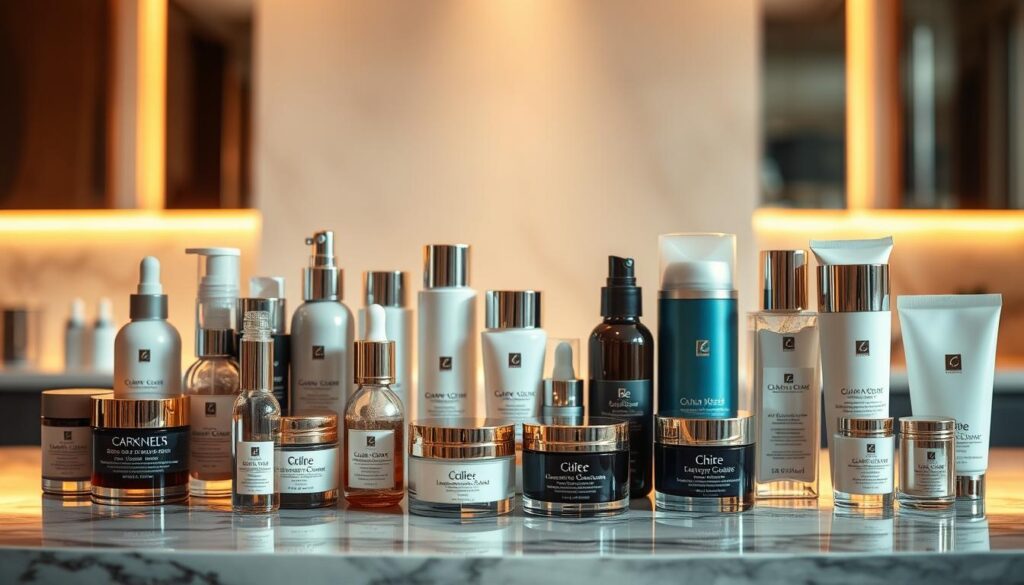
Finding the right skincare can be tough. You want luxury products that really work. Let’s look at some top brands that impress both doctors and users.
These brands use science to tackle different skin problems. Here are some great choices:
- SkinCeuticals: A favorite among dermatologists for over 20 years
- Drunk Elephant: Offers powerful products like the T.L.C. Sukari Babyfacial
- The Ordinary: Affordable luxury with clear ingredients
- Neutrogena: The go-to for dermatologists at drugstores
When picking luxury skincare, think about these things:
- Quality of ingredients
- Science behind the products
- What your skin needs
- Value for the price
“Invest in your skin. It’s going to represent you for a very long time.” – Unknown
Some top products include SkinMedica’s TNS Advanced+ Serum and BeautyStat’s Universal C Skin Refiner. They help with skin tone and texture.
Finding the right brand is all about your skin. Do your research, test, and ask experts for advice.
Clean Beauty vs Clinical Formulations
The skincare world is changing fast. Clean beauty brands and clinical formulations are leading the way. It’s key to know the difference between them.
Clean beauty focuses on natural, safe ingredients. These products are cruelty-free and good for the planet. They avoid harmful chemicals and use plant-based ingredients.
Understanding Clean Beauty Standards
Clean beauty brands aim to avoid harmful substances. They don’t use parabens, sulfates, or synthetic fragrances. This movement values:
- Natural ingredients
- Less harm to the environment
- Responsible manufacturing
- No animal testing
Benefits of Clinical-Grade Products
Clinical formulations use science to solve skin problems. They have strong active ingredients. The benefits are:
- More active ingredients
- Deals with serious skin issues
- Proven to work
- Based on advanced research
Making the Right Choice for Your Skin
Choosing between clean beauty and clinical formulations depends on your skin. Think about your skin type, concerns, and values. Some might mix both for the best results.
The main thing is to find products that match your skin and values.
Dermatologist-Recommended Product Lines
Discovering the right skincare can change your beauty routine without spending a lot. Top skincare experts often recommend certain brands. These brands offer great results for different skin issues.
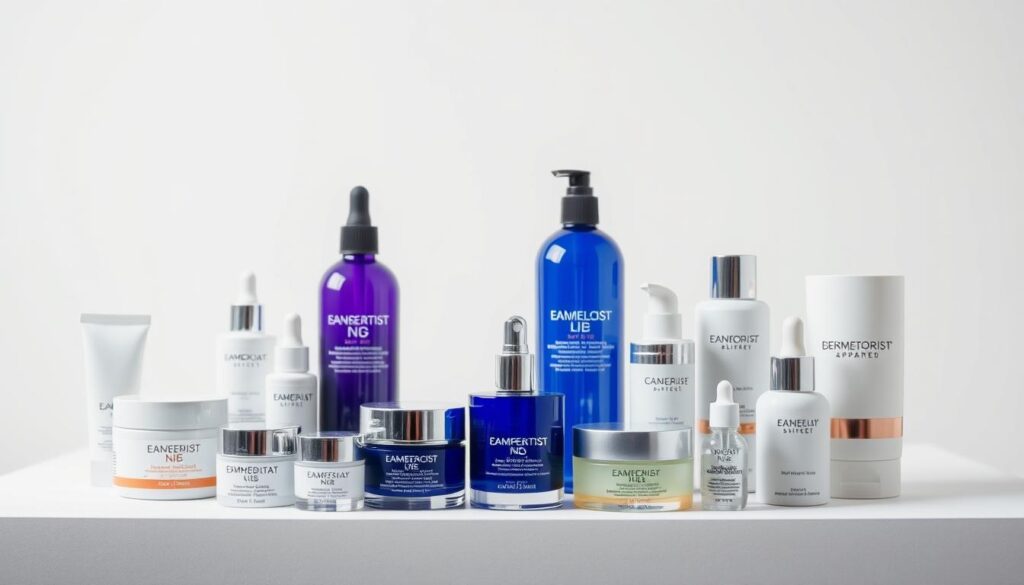
When looking for dermatologist-recommended skincare, consider these brands:
- La Roche-Posay: Known for the Effaclar Duo [+] Anti-Imperfections Moisturiser, highly praised by dermatologists
- CeraVe: An affordable brand offering scientifically formulated products like their Hydrating Cleanser
- SkinCeuticals: Recognized for advanced anti-aging formulas like C E Ferulic Serum
- EltaMD: The top recommended sunscreen brand among dermatology professionals
You don’t need to spend a lot to find great skincare. Many top options are available at drugstores and online. The important thing is to know what your skin needs and choose products with effective ingredients.
Studies show that brands like SkinCeuticals and EltaMD get high praise from experts and users. For example, EltaMD UV Clear Broad-Spectrum SPF 46 has a 4.79-star rating from over 5,000 reviews.
Natural vs Synthetic Ingredients: What Works Better
The world of skincare is complex and often misunderstood. Choosing between natural and synthetic ingredients is a big decision. Knowing the differences can help you pick the best for your skin.
Common Misconceptions About Natural Products
Many think natural skincare is safer and more effective. But, 70% of people prefer natural ingredients, even if they don’t always work better. Natural doesn’t always mean safer or gentler.
- Natural ingredients can trigger allergic reactions
- Some natural oils can cause skin irritation
- Not all natural extracts are beneficial for skin
The Science Behind Synthetic Ingredients
Synthetic ingredients offer precise solutions for skin problems. Clinical studies show 60% of cosmetic chemists prefer them for consistent results. These ingredients are engineered to target specific skin issues with great precision.
| Synthetic Ingredient | Key Benefit | Effectiveness |
|---|---|---|
| Hyaluronic Acid | Hydration | Can hold 1,000x its weight in water |
| Retinol | Anti-aging | Reduces wrinkles up to 30% |
| Salicylic Acid | Acne Treatment | Reduces acne lesions by 50% |
Finding the Right Balance
Finding the right balance in skincare is key. 65% of consumers prefer products that mix natural and synthetic ingredients. Your skin’s needs should guide your choice, considering sensitivity, specific concerns, and personal preferences.
- Evaluate your skin type
- Consider product ingredients carefully
- Consult with skincare professionals
Remember, the most important factor is how your skin responds to a product, not whether it’s natural or synthetic.
Price Points and Value Assessment
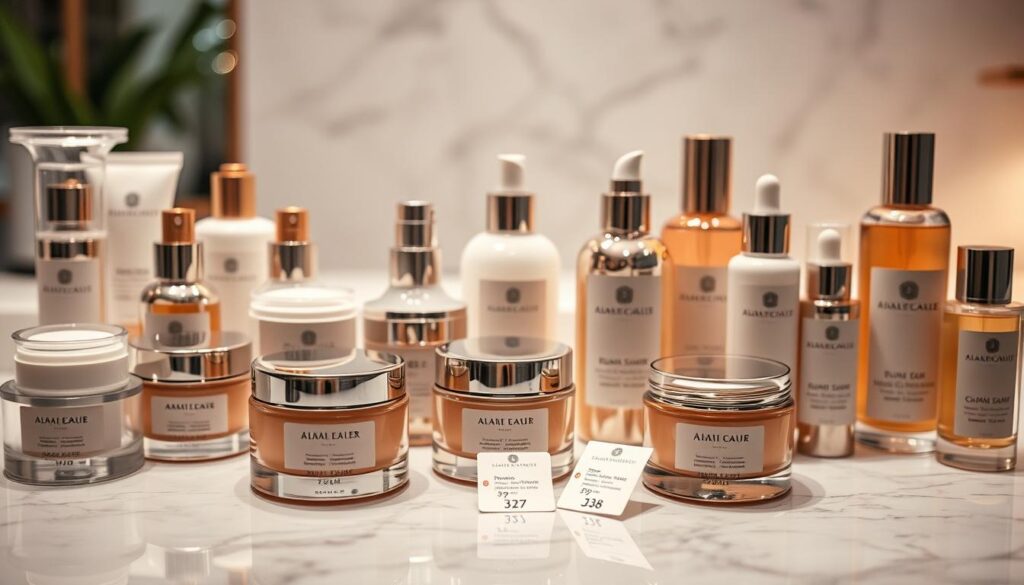
Exploring luxury skincare products can be a bit tricky. Prices vary from $10 to $500 for a single moisturizer. It’s important to understand value to make smart choices.
The US facial skincare market is expected to hit over $13 billion by 2028. This shows the industry is growing fast with many price options. When looking at luxury skincare, consider these important points:
- Ingredient quality and concentration
- Brand reputation and research
- Scientific formulation
- Potential long-term skin benefits
Market trends show that younger buyers are looking to spend more on skincare. This means price isn’t the only thing that matters. Brands need to show how their products deliver results to be worth the cost.
Brands like L’Oréal, CeraVe, and La Roche-Posay show that good marketing and results can justify higher prices. The Vogue Business Beauty Index says quality, innovation, and what others say about a product also matter.
When choosing skincare, think about what you can afford and what you hope to get. Not every pricey product is the best. Sometimes, cheaper options can work just as well.
Remember: The most expensive product isn’t always the best for your unique skin needs.
Product Testing and Safety Considerations
Exploring skincare safety means making smart choices. The cosmetic world is guided by rules to keep us safe. Knowing about product testing and safety is key for those who choose cruelty-free skincare.
Important safety points for skincare include:
- Comprehensive microbiological testing
- Ingredient safety assessments
- Regulatory compliance checks
- Patch testing for individual sensitivity
Groups like the FDA and EU Cosmetics Regulation are vital for safety. Cruelty-free skincare means more than avoiding animal tests. It also means strict safety and ethical making.
“Safety isn’t an option in skincare; it’s a fundamental requirement.” – Skincare Safety Expert
Before adding new products, follow these safety steps:
- Do a patch test on a small skin area
- Look at ingredient lists for allergens
- Make sure the brand is cruelty-free
- Learn about the product’s safety tests
Choosing cruelty-free skincare and brands that test safely keeps your skin safe. It also supports fair beauty.
The Importance of Proper Storage and Expiration Dates
Keeping your korean skincare routine going is more than picking the right products. It’s also about storing them right and knowing when they expire. This helps keep your skincare fresh and your skin healthy.
Storage conditions are key for your korean skincare routine. Most products are sensitive to things like light and humidity. These factors can harm their quality.
Optimal Storage Conditions
To keep your skincare products fresh, follow these tips:
- Store them in a cool, dry spot away from sunlight
- Keep them sealed when not using them
- Avoid humid places like bathrooms
- Keep the room temperature steady
Understanding Product Shelf Life
Skincare products have different lifespans. Creams and liquids last 6-12 months after opening. Powders can last 2-3 years.
Signs of Product Deterioration
Look out for these signs that your product has gone bad:
- Color or texture changes
- Unusual smell
- Ingredients separating
- It doesn’t work as well
70% of women have used expired skincare products, increasing potential skin risks.
Keeping your skin safe means watching for expired products. Always check the “period after opening” (PAO) symbol. Toss products that look or smell off to keep your skincare routine strong.
Conclusion
Finding the best skincare brands can seem hard, but with the right info, you can make great choices. You’ll learn about brands like CeraVe and Augustinus Bader. It’s all about knowing what your skin needs and looking at ingredients that really help.
Your skincare journey is all about you and keeps changing. Brands like Dr. Loretta and SK-II show how new science and old wisdom can work together. Whether you’re looking at vegan options like Chantecaille or high-performance products from SkinCeuticals, remember that changing your skin takes time and effort.
The best skincare brands meet your skin type, solve your problems, and fit your budget. Studies show amazing results, like Chantecaille’s Bio Lifting Mask+ which gave 82% of users an instant lift. By staying up-to-date and flexible, you’ll create a skincare routine that makes you look and feel better.
Your skin is special, and so should your skincare routine. Keep learning, stay curious, and try out different brands until you find the one that’s just right for you.
FAQ
How do I choose the right skincare brand for my skin type?
To find the right skincare brand, first figure out your skin type and what you’re worried about. Think about how oily or dry your skin is, and if you have acne or wrinkles. Look for brands that dermatologists recommend and that offer products for your specific skin needs.
Always check the ingredients list. And don’t hesitate to ask a skincare expert for advice tailored to you.
What does “clean beauty” really mean?
Clean beauty means products without harmful stuff like parabens, sulfates, and artificial scents. These brands use natural, safe ingredients but still work well. But remember, “clean” doesn’t always mean it’s the best for you. Look at the ingredients and how they help your skin.
Are expensive skincare products always more effective?
No, they’re not always better. Luxury brands use top-notch ingredients and formulas, but affordable options can work just as well. It’s about the active ingredients, their strength, and how they solve your skin problems. Some affordable brands get great results too.
How important are natural ingredients in skincare?
Natural ingredients can be good, but they’re not always better than synthetic ones. Some natural stuff works great, while others might not be as strong. What matters most is finding what works for your skin, whether it’s natural or made in a lab.
How often should I change my skincare routine?
Your skincare routine should change as your skin does. Things like getting older, moving to a new place, or changes in your health can affect your skin. You might need to update your routine with the seasons or when your current products stop working. But don’t change everything at once. Try new things slowly and test them first.
What ingredients should I look for in anti-aging skincare?
For anti-aging, look for retinol, vitamin C, hyaluronic acid, peptides, and ceramides. Retinol boosts cell turnover and collagen, vitamin C protects against damage, hyaluronic acid hydrates, peptides improve elasticity, and ceramides keep your skin barrier strong. Always talk to a dermatologist to make a plan that’s right for you.
How can I determine my skin type?
To find out your skin type, see how it feels and looks all day. Oily skin is shiny and feels oily, dry skin is tight and flaky, combination skin is both, and sensitive skin gets red and irritated easily. A pro skin analysis or a dermatologist’s advice is the best way to know for sure.
Are cruelty-free skincare brands really different?
Cruelty-free skincare means it wasn’t tested on animals. It doesn’t mean it works better, but it shows the brand cares about animals. Many top skincare brands are now cruelty-free. Look for the cruelty-free logo from trusted groups when you shop.

